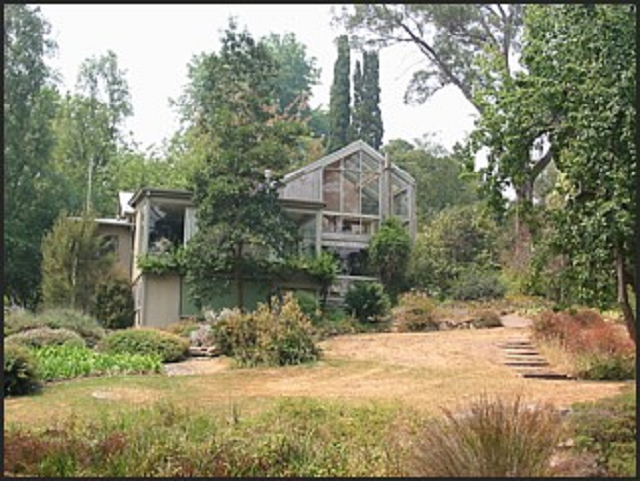
By Mikayla van Loon
A piece of history in Mount Evelyn is soon to be divided but before it does become two properties, it seemed only fitting to look back at it’s past.
Cherrygarth, the property located at 14 East Avenue, was the home of Friedl and Godfrey Gardner from 1959 until it was sold in 2005.
The artist and her academic husband purchased the beautifully landscaped property then known as ‘Wrenloft’ from Mary and Norm Doeg, before renaming the property ‘Cherrygarth’ to mean ‘rosy cheeks’ and ‘garden’.
As a well known figure in the Mount Evelyn community, it wasn’t hard to find someone who knew Freidl.
Friend and fellow environmental warrior Clare Worsnop said Friedl really helped guide her to become the Mount Evelyn Environment Protection and Progress president.
“Friedel was always very community minded. The two of them were but Friedl was the one that I had the most to do with because she just took me under her wing as a little protege that needed to be guided and helped to understand the magic of the world,” Clare said.
Friedl’s father, Victor Rathausky, who came to Australia from Austria in 1912, had a great love and appreciation for the natural world, a trait he passed to his daughter when she was born in 1920.
“She was very interested in the wildlife, she was very interested in the flora of the area, I think probably the flora was her greatest strength rather than fauna, which is probably mine,” Clare said.
“The flora and fauna of Australia was very special to her and the flora and fauna of Mount Evelyn was very, very special.
“So the property was pretty natural, with natural bush, lots of big eucalypts on it, and lots of beautiful ferns and stuff on the undergrowth.”
Clare said one of Friedl’s aims with the two acre property was to remove all the invasive weeds to support regeneration.
“She always said she wasn’t an absolute purist but she needed to get rid of all the invasive weeds and encouraged and replanted and revegetated, where she could, natural vegetation which would enhance the magical spot.”
One of Friedl’s most prized sections of her garden was the duck pond she created with water lilies, which became home to a new brood of ducklings every year.
Not only did Friedl want to create a garden for her own pleasure but to share and teach others the importance of nature and the need to protect it.
“She loved to teach people but in a passive way so that when you go there you see the magic and then she can talk about it and infect you with what you need to know rather than stand up and give you a lecture,” Clare said.
Friedl’s garden became a safe haven for many species including kangaroos, wallabies and the endangered grey goshawks that are no longer found in Mount Evelyn.
Disappointed to not only lose this patch of natural environment for the flora and fauna in Mount Evelyn, Clare said it was also sad to see Friedl’s history disappearing.
The Mount Evelyn History Group have requested the history of Cherrygarth and the Gardner’s be remembered, with the owners of many properties of historical significance celebrating the past with photos and continuing the history in some sort of dedication.
Speaking as a citizen of Mount Evelyn, Paula Herlihy said it’s places like Cherrygarth that create a sense of belonging, family and purpose.
“The more the character of our ‘place’ is lost in ways like the subdivision of Cherrygarth, the less attached we are, the less likely we are to protect it and volunteer to improve it,” Paula said.
“Eventually we incline towards the behaviour of those people we read about who don’t know their neighbours and don’t know if they become ill or even die.
“Our history is part of what attaches us to a place. Every tree, plant and animal lost, every garden destroyed disrupts that link to our ‘place’ or ‘country’.”
Friedl and Godfrey found their home in Mount Evelyn, choosing a place that was not surrounded by ‘suburbs’ and worked hard to protect it.
Being born to migrant parents and living through a world war, Friedl knew about hard work and supporting those less fortunate. She didn’t always have a lot of money in her early adult life.
“When she started doing her paintings, her watercolours, she couldn’t afford all the really good papers she wanted. If she stuffed one up, she would literally soak them in the water in a bath until the colours came out and then she’d dry it and reuse it,” Clare said.
“She respected the fact that a lot of people aren’t fortunate but a bit of caring, nurturing and affection and good attitude can make a big difference in any small way.”
Friedl would often sell postcards of her paintings or host exhibitions to raise money for Amnesty International, mostly with designs inspired by the flora found in her garden.
Mount Evelyn History Group’s Janice Newton was able to secure a diary entry from Friedl’s daughter Margot, describing the beauty of the garden in 1968 – a lasting memory of what was once before.
“Take a walk around the garden with me in your imagination – down the stepping stones past the delicate birch trees and the pink belladonnas which have appeared all around the garden,” it read.
“The perfume of the Bouvardia is worth a short crawl on hands and knees; down the gravel steps past the laundry and then across the grassy stretch and lilac border, right down to the round bed.
“Over the potting yard … the jasmine climbs freely and to reach a bloom amongst the jungle of creepers, blackberries and roses is a real treat – the perfume is really beautiful. Come around past the gully, through the paddocks to the orchard. The rosy apples on the trees are quite tempting – so crisp and juicy.”







